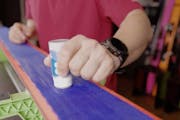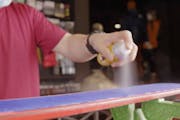Ruedi Thomi, Somara Frick.
In the video, sales advisor Perseo explains how to properly waterproof, care for and store ski touring skins. He gives advice on when to use liquid wax or spray and how waterproofing using heat works..
The skins on your touring skis need to be regularly cared for. How often you do this depends mainly on how often you use your skis. And, of course, how much you bother about your equipment. If you avoid leaving areas wet and dirty for example, your skins will stay clean and functional for longer..
In the video, sales advisor Perseo explains how to properly care for your skins and keep them clean. He also discusses the differences between different types of wax and how to apply them..
Three types of waterproofing.
If you’ve ever been ski touring and experienced snow getting stuck to your skins, you’ve probably learned your lesson by now. To waterproof the skins, you apply a water-repellent layer of wax not just to the hairs of the skins but also to the fabric between the skin and the glue. This is usually made of cotton..
Non-fluorinated wax
There is a wide range of different wax products to choose from. We will gladly advise you on this in our stores. Here’s a good first tip: go for fluorine-free wax. Fluorine residues get into the soil and are harmful to nature. We only supply wax products without this destructive ingredient – for the sake of the environment.
We distinguish between two types of products: ones that you can take with you on tour and use on the fly, and those that need to be left on slightly longer or applied more thoroughly..

For on the go
Liquid or semi-hard: you can take wax in a tube or as a stick with you on your tour. You can freshen up not just your skins, but your skis too by applying a layer of wax while you’re on the move. The wax can be applied quickly.

Fast application
Ski wax spray can be applied lightning fast, but you have to allow from thirty minutes to several hours for it to work in. So, this version is not one for your daypack..

Hot waxing
Effective and economical: spread a conventional solid wax, the same one you use for your touring skis, over the ski skin by applying a little pressure until a white film forms. Then blow-dry the wax thoroughly so that it penetrates into the deeper layers of the skin for long-lasting results. When you blow-dry, make sure you only use a low heat setting. This takes a bit longer, but preserves the synthetic fibres of the coat..
Drying and storing your skins
When you return from your tour, first leave your wet ski skins to dry completely.The best way to do this is to hang the skins up in a dry room at room temperature. If the skins are dirty, clean them with a damp cloth. Don’t place skins on a radiator to dry, as intense heat can damage the adhesive layer, causing the skins to dry out and become brittle..
As soon as they are dry, stick the skins back together or onto the netting so that no dust or dirt collects on the adhesive. Never roll up a skin individually. This is because the hairs will stick to the top of the skin, and when you unroll it again, you will tear them off. The skin will then have less grip on the snow.
Share the articleCaring for and waterproofing ski skins properly
- Free shipping from CHF 99
(With the TransaCard always free of charge)
- Secure payment with Twint, Visa and more
- 14 days cancellation right
